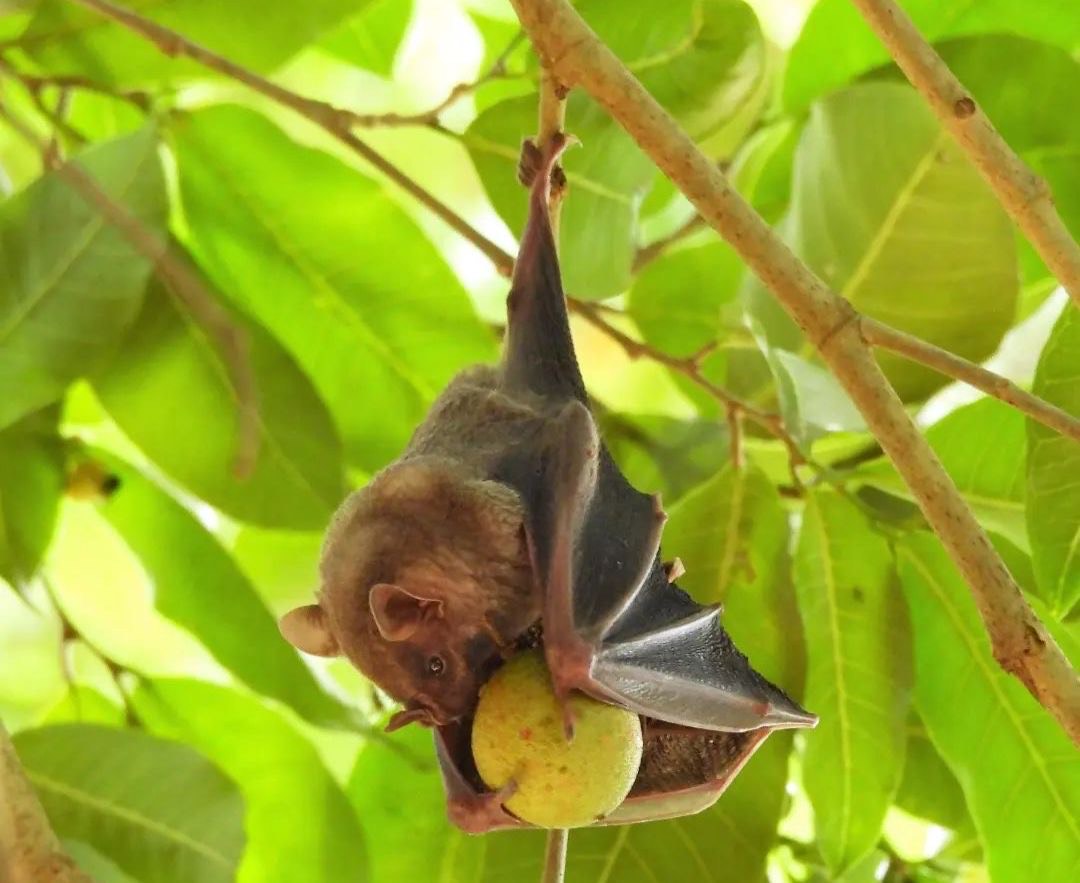Consumo diurno de fruto por Artibeus lituratus en Coclé, República de Panamá
Contenido principal del artículo
Resumen
Se presenta la primera observación de consumo diurno de fruto en el murciélago frugívoro Artibeus lituratus en un bosque húmedo tropical de la República de Panamá. El individuo fue observado alimentándose de día en un árbol de guayaba (Myrtaceae). Se trata del primer caso reportado de este inusual comportamiento en Centroamérica.
Detalles del artículo

Esta obra está bajo una licencia internacional Creative Commons Atribución-NoComercial-SinDerivadas 4.0.
Revista Mexicana de Mastozoología, nueva época por Instituto de Ecología, UNAM. Se distribuye bajo una Licencia Creative Commons Atribución-NoComercial-CompartirIgual 4.0 Internacional.
Basada en una obra en http://revistamexicanademastozoologia.com.mx/ojs/index.php/rmm.
Métricas de PLUMX
Citas
Angehr, G. y R. Dean. 2010. The Birds of Panama A Field Guide. 1era. ed. Zona Tropical, Zona Creativa S.A., Cornell University Press. Ithaca, Estados Unidos.
Bôlla, D., F. Carvalho, J.J. Zocche, A. Bianco, J.A. de Bittencourt-Vitto y R. Da Santos. 2017. Phyllostomid bats flying in daylight: a case from the Neotropics. Journal of Natural History, 51: 2947-2953. https://doi.org/10.1080/00222933.2017.1397227
Bôlla, D., R. L. M. Mornin y F. Carvalho. 2023. Bats got a place in the sun: new findings of daytime flight in Brazil. Theyra Notes, 4: 129-134. https://doi.org/10.12933/therya_notes-23-119
Clare, E. L., H. R. Goerlitz, V. A. Drapeau, M. W. Holderied, A. M. Adams, J. Nagel, E. R. Dumont, P. D. N. Hebert y M. B. Fenton. 2014. Trophic niche flexibility in Glossophaga soricina: how a nectar seeker sneaks an insect snack. Functional Ecology, 28:632-641. https://doi.org/10.1111/1365-2435.12192
Carpenter, R. E. 1969. Structure and function of the kidney and the water balance of desert bats. Physiological Zoology, 42:288-302.
Chua, M. y S. Aziz. 2019. Into the light: atypical diurnal foraging activity of Blyth’s horseshoe bat, Rhinolophus lepidus (Chiroptera: Rhinolophidae) on Tioman Island, Malaysia. Mammalia, 83: 78-83. https://doi.org/10.1515/mammalia-2017-0128
Díaz, M.M., R.G. Solari, L.F. Aguirre y R.M. Barquez. 2021. Clave de identificación de los murciélagos neotropicales. Publicación especial #4-PCMA (Programa de conservación de los murciélagos de Argentina). Tucumán, Argentina.
Fleming, T. H., A. A. Nelson y V. M. Dalton. 1998. Roosting behavior of the lesser long-nosed bat, Leptonycteris curasoae. Journal of Mammalogy, 79: 147–155. https://doi.org/10.2307/1382849
Hernández-Mijangos, L. A. y R. Medellín. 2009. Observaciones sobre el consumo de fruto de Psidium guajava por Artibeus lituratus. Revista Mexicana de Mastozoología, 13: 105-108. https://doi.org/10.22201/ie.20074484e.2009.13.1.39
Hoyos-Díaz, J. M. y M. Muñoz-Romo. 2022. Actividad nocturna de Artibeus planirostris y Artibeus lituratus (Chiroptera: Phyllostomidae), durante dos fases lunares en una localidad de los Andes Venezolanos. Revista Mexicana de Mastozoología nueva época, 12(2): 32-43. https://doi.org/10.22201/ie.20074484e.2022.12.2.373
Kunz, T. H. y L. F. Lumsden. 2003. Ecology of cavity and foliage roosting bats. Pp. 3–89, en: Bat Ecology (Kunz, T. H. y M. B. Fenton, eds.). University of Chicago Press, Chicago, Estados Unidos.
Larsen, P. A., M. R. Marchán-Rivadeneira y R. J. Baker. 2010. Taxonomic status of Andersen’s fruit-eating bat (Artibeus jamaicensis aequatorialis) and revised classification of Artibeus (Chiroptera: Phyllostomidae). Zootaxa, 2648: 45-60. https://doi.org/10.11646/zootaxa.2648.1.3
Larsen, P. A., Marchán-Rivadeneira, M. R., & Baker, R. J. 2013. Speciation dynamics of the fruit-eating bats (genus Artibeus): with evidence of ecological divergence in Central American populations. Bat evolution, ecology, and conservation, 315-339. https://doi.org/10.1007/978-1-4614-7397-8_16
LaVal, R. y R. Bernal. 2002. Murciélagos de Costa Rica. 1era ed., Instituto Nacional de Biodiversidad (INBIO), Costa Rica.
Marchán-Rivadeneira, M. R., Larsen, P., Phillips, C., Strauss, R. y Baker, R. 2012. On the association between environmental gradients and skull size variation in great fruit-eating bat, Artibeus lituratus (Chiroptera: Phyllostomidae). Biological Journal of the Linnean Society, 105: 623-634. https://doi.org/10.1111/j.1095-8312.2011.01804.x
Mikula, P., F. Morelli, R. K. Lučan, D. N. Jones y P. Tryjanowski. 2016. Bats as prey of diurnal birds: a global perspective. Mammal Review, 46: 160–174. https://doi.org/10.1111/mam.12060
Muñoz-Romo, M. 2006. Ethogram and diurnal activities of a colony of Artibeus lituratus (Phyllostomidae: Stenodermatinae). Acta Chiropterologica, 8: 231-238. https://doi.org/10.3161/1733-5329(2006)8[231:EADAOA]2.0.CO;2
Muñoz-Romo, M. y E. A. Herrera. 2010. Observaciones sobre la alimentación del murciélago frugívoro mayor Artibeus lituratus (Chiroptera: Phyllosotmidae) en Venezuela. Revista Mexicana de Mastozoología, 14: 51-58. https://doi.org/10.22201/ie.20074484e.2010.14.1.27
Reid, F.A. 2009. A field guide of the mammals of Central American & southeast Mexico. 2da. ed., Oxford University Press. Nueva York, Estados Unidos.
Russo, D., L. Cistrone, A.P. Garonna y G. Jones. 2011a. The early bat catches the fly: daylight foraging in soprano pipistrelles. Mammalian Biology, 76: 87–89. https://doi.org/10.1016/j.mambio.2009.08.002
Russo, D., G. Maglio, A. Rainho, C. F. J. Meyer y J. M. Palmeirim. 2011b. Out of the dark: diurnal activity in the bat Hipposideros ruber on São Tomé Island (West Africa). Mammalian Biology, 76: 701–708. https://doi.org/10.1016/j.mambio.2010.11.007
Rydell, J. y J. R. Speakman. 1995. Evolution of nocturnality in bats: potential competitors and predators during their early history. Biological Journal of the Linnean Society, 54: 183–191. https://doi.org/10.1111/j.1095-8312.1995.tb01031.x
Speakman, J.R., 1995. Chiropteran nocturnality. Symposia of the Zoological Society of London, 67: 187–201.
Speakman, J.R., J. Rydell, P. I. Webb, J. P. Hayes, G.G. Hays, I. A. R. Hulbert y R. M. McDevitt. 2000. Activity patterns of insectivorous bats and birds in northern Scandinavia (69 degrees N), during continuous midsummer daylight. Oikos, 88: 75–86. https://doi.org/10.1034/j.1600-0706.2000.880109.x
Vivas-Toro, I. y O. E. Murillo-García. 2020. Diurnal Flying Activity of a Neotropical Bat (Saccopteryx leptura): Effect of Light Intensity, Temperature, and Canopy Cover, Acta Chiropterologica, 22: 87-94. https://doi.org/10.3161/15081109ACC2020.22.1.008
Vonhof, M. J. y C. Kalconius. 1999. Lavia frons. Mammalian species, 614: 1-4.
York, H.A., B. Rodríguez-Herrera, R. LaVal y R. Timm. 2019. Field keys to the bats of Costa Rica and Nicaragua. Journal of Mammalogy, 100: 1726-1749. https://doi.org/10.1093/jmammal/gyz150
Weinbeer, M., C. F. J. Meyer y E. K. V. Kalko. 2006. Activity pattern of the trawling phyllostomid bat, Macrophyllum macrophyllum, in Panama. Biotropica, 38: 69–76. https://doi.org/10.1111/j.1744-7429.2006.00101.x
Wilson, D.E. y R.A. Mittermeier. 2019. Handbook of the Mammals of the World. Vol. 9. Bats. Lynx Edicions, Barcelona.

